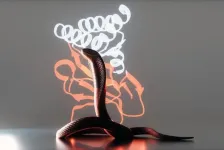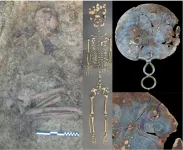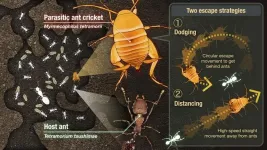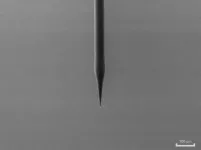(Press-News.org) CAMBRIDGE, MA -- Nearly 50 years ago, neuroscientists discovered cells within the brain’s hippocampus that store memories of specific locations. These cells also play an important role in storing memories of events, known as episodic memories. While the mechanism of how place cells encode spatial memory has been well-characterized, it has remained a puzzle how they encode episodic memories.
A new model developed by MIT researchers explains how those place cells can be recruited to form episodic memories, even when there’s no spatial component. According to this model, place cells, along with grid cells found in the entorhinal cortex, act as a scaffold that can be used to anchor memories as a linked series.
“This model is a first-draft model of the entorhinal-hippocampal episodic memory circuit. It’s a foundation to build on to understand the nature of episodic memory. That’s the thing I’m really excited about,” says Ila Fiete, a professor of brain and cognitive sciences at MIT, a member of MIT’s McGovern Institute for Brain Research, and the senior author of the new study.
The model accurately replicates several features of biological memory systems, including the large storage capacity, gradual degradation of older memories, and the ability of people who compete in memory competitions to store enormous amounts of information in “memory palaces.”
MIT Research Scientist Sarthak Chandra and Sugandha Sharma PhD ’24 are the lead authors of the study, which appears today in Nature. Rishidev Chaudhuri, an assistant professor at the University of California at Davis, is also an author of the paper.
An index of memories
To encode spatial memory, place cells in the hippocampus work closely with grid cells — a special type of neuron that fires at many different locations, arranged geometrically in a regular pattern of repeating triangles. Together, a population of grid cells forms a lattice of triangles representing a physical space.
In addition to helping us recall places where we’ve been, these hippocampal-entorhinal circuits also help us navigate new locations. From human patients, it’s known that these circuits are also critical for forming episodic memories, which might have a spatial component but mainly consist of events, such as how you celebrated your last birthday or what you had for lunch yesterday.
“The same hippocampal and entorhinal circuits are used not just for spatial memory, but also for general episodic memory,” Fiete says. “The question you can ask is what is the connection between spatial and episodic memory that makes them live in the same circuit?”
Two hypotheses have been proposed to account for this overlap in function. One is that the circuit is specialized to store spatial memories because those types of memories — remembering where food was located or where predators were seen — are important to survival. Under this hypothesis, this circuit encodes episodic memories as a byproduct of spatial memory.
An alternative hypothesis suggests that the circuit is specialized to store episodic memories, but also encodes spatial memory because location is one aspect of many episodic memories.
In this work, Fiete and her colleagues proposed a third option: that the peculiar tiling structure of grid cells and their interactions with hippocampus are equally important for both types of memory — episodic and spatial. To develop their new model, they built on computational models that her lab has been developing over the past decade, which mimic how grid cells encode spatial information.
“We reached the point where I felt like we understood on some level the mechanisms of the grid cell circuit, so it felt like the time to try to understand the interactions between the grid cells and the larger circuit that includes the hippocampus,” Fiete says.
In the new model, the researchers hypothesized that grid cells interacting with hippocampal cells can act as a scaffold for storing either spatial or episodic memory. Each activation pattern within the grid defines a “well,” and these wells are spaced out at regular intervals. The wells don’t store the content of a specific memory, but each one acts as a pointer to a specific memory, which is stored in the synapses between the hippocampus and the sensory cortex.
When the memory is triggered later from fragmentary pieces, grid and hippocampal cell interactions drive the circuit state into the nearest well, and the state at the bottom of the well connects to the appropriate part of the sensory cortex to fill in the details of the memory. The sensory cortex is much larger than the hippocampus and can store vast amounts of memory.
“Conceptually, we can think about the hippocampus as a pointer network. It’s like an index that can be pattern-completed from a partial input, and that index then points toward sensory cortex, where those inputs were experienced in the first place,” Fiete says. “The scaffold doesn’t contain the content, it only contains this index of abstract scaffold states.”
Furthermore, events that occur in sequence can be linked together: Each well in the grid cell-hippocampal network efficiently stores the information that is needed to activate the next well, allowing memories to be recalled in the right order.
Modeling memory cliffs and palaces
The researchers’ new model replicates several memory-related phenomena much more accurately than existing models that are based on Hopfield networks — a type of neural network that can store and recall patterns.
While Hopfield networks offer insight into how memories can be formed by strengthening connections between neurons, they don’t perfectly model how biological memory works. In Hopfield models, every memory is recalled in perfect detail until capacity is reached. At that point, no new memories can form, and worse, attempting to add more memories erases all prior ones. This “memory cliff” doesn’t accurately mimic what happens in the biological brain, which tends to gradually forget the details of older memories while new ones are continually added.
The new MIT model captures findings from decades of recordings of grid and hippocampal cells in rodents made as the animals explore and forage in various environments. It also helps to explain the underlying mechanisms for a memorization strategy known as a memory palace. One of the tasks in memory competitions is to memorize the shuffled sequence of cards in one or several card decks. They usually do this by assigning each card to a particular spot in a memory palace — a memory of a childhood home or other environment they know well. When they need to recall the cards, they mentally stroll through the house, visualizing each card in its spot as they go along. Counterintuitively, adding the memory burden of associating cards with locations makes recall stronger and more reliable.
The MIT team’s computational model was able to perform such tasks very well, suggesting that memory palaces take advantage of the memory circuit’s own strategy of associating inputs with a scaffold in the hippocampus, but one level down: Long-acquired memories reconstructed in the larger sensory cortex can now be pressed into service as a scaffold for new memories. This allows for the storage and recall of many more items in a sequence than would otherwise be possible.
The researchers now plan to build on their model to explore how episodic memories could become converted to cortical “semantic” memory, or the memory of facts dissociated from the specific context in which they were acquired (for example, Paris is the capital of France), how episodes are defined, and how brain-like memory models could be integrated into modern machine learning.
###
The research was funded by the U.S. Office of Naval Research, the National Science Foundation under the Robust Intelligence program, the ARO-MURI award, the Simons Foundation, and the K. Lisa Yang ICoN Center.
END
How one brain circuit encodes memories of both places and events
A new computational model explains how neurons linked to spatial navigation can also help store episodic memories.
2025-01-15
ELSE PRESS RELEASES FROM THIS DATE:
ASU-led collaboration receives $11.2 million to build a Southwest Regional Direct Air Capture Hub
2025-01-15
Arizona State University and a team of its collaborators have received $11.2 million in funding from the U.S. Department of Energy to begin developing a regional Direct Air Capture (DAC) Hub for removing carbon dioxide (CO2) from the atmosphere. The team will prepare to build a multi-site Direct Air Capture Hub located in the Four Corners area of the Southwestern United States. Additionally, the project will receive $11.2 million in matching funds from the project partners.
In May of 2022, the Biden administration announced the Bipartisan Infrastructure Law’s $3.5 billion DOE program to establish large-scale Direct Air Capture Hubs for removing carbon ...
Study finds strategies to minimize acne recurrence after taking medication for severe acne
2025-01-15
Isotretinoin, commonly referred to as Accutane, is the only approved medical treatment capable of inducing long-term remission of severe acne. Although highly effective, some individuals experience recurrence of acne after a course of treatment. A new study from researchers at Mass General Brigham examined how often acne recurs after isotretinoin and what factors might put patients at risk of acne coming back. They found that acne recurrence necessitating treatment with an oral medication such as oral antibiotics, spironolactone, or another ...
Deep learning designs proteins against deadly snake venom
2025-01-15
New proteins not found in nature have now been designed to counteract certain highly poisonous components of snake venom. The deep learning, computational methods for developing these toxin-neutralizing proteins offer hope for creating safer, more cost-effective and more readily available therapeutics than those currently in use.
Each year more than 2 million people suffer snakebites. More than 100,000 of them die, according to the World Health Organization, and 300,000 suffer severe complications and lasting disability ...
A new geometric machine learning method promises to accelerate precision drug development
2025-01-15
Proteins are the foundation of all life we currently know. With their virtually limitless diversity, they can perform a broad variety of biological functions, from delivering oxygen to cells and acting as chemical messengers to defending the body against pathogens. Furthermore, most biochemical reactions are only possible thanks to enzymes, a special type of protein catalysts.
The molecular surface of proteins is the key to their function, such as docking small molecules or other proteins or driving ...
Ancient genomes reveal an Iron Age society centred on women
2025-01-15
An international team of geneticists, led by those from Trinity College Dublin, has joined forces with archaeologists from Bournemouth University to decipher the structure of British Iron Age society, finding evidence of female political and social empowerment.
The researchers seized upon a rare opportunity to sequence DNA from many members of a single community. They retrieved over 50 ancient genomes from a set of burial grounds in Dorset, southern England, in use before and after the Roman Conquest of AD 43. The results revealed that this community was centred around bonds of female-line descent.
Dr Lara Cassidy, Assistant Professor in Trinity’s Department of Genetics, led ...
How crickets co-exist with hostile ant hosts
2025-01-15
Researchers at Nagoya University in Japan have discovered sophisticated behavioral strategies that enable parasitic crickets to survive within ant colonies. Led by Ryoya Tanaka, the team documented how these insects successfully navigate life among potentially lethal hosts through precise evasion tactics. Their findings, published in Communications Biology, reveal remarkable adaptations that allow these cricket species to thrive in a hostile environment.
Animals that live in ant colonies, known as “ant guests”, exploit their hosts’ resources. However, this ...
Tapered polymer fibers enhance light delivery for neuroscience research
2025-01-15
WASHINGTON — Researchers have developed a reliable and reproducible way to fabricate tapered polymer optical fibers that can be used to deliver light to the brain. These fibers could be used in animal studies to help scientists better understand treatments and interventions for various neurological conditions.
The tapered fibers are optimized for neuroscience research techniques, such as optogenetic experiments and fiber photometry, which rely on the interaction between genetically modified neurons and visible light delivered to and/or collected from the brain.
“Unlike standard optical fibers, which are cylindrical, the tapered fibers we developed have a conical shape, which ...
Syracuse University’s Fran Brown named Paul “Bear” Bryant Newcomer Coach of the Year Award recipient
2025-01-15
HOUSTON, January 15, 2025 — The American Heart Association has named Syracuse University’s Fran Brown as the recipient of the 2024 Paul “Bear” Bryant Newcomer Coach of the Year Award. This award celebrates the achievements of an individual who has not had any previous head coaching experience at the NCAA Division I football sub-division (FBS) level.
Coach Brown will be recognized with the honor during the 2025 Bear Bryant Awards on January 22.
After being named Syracuse’s 31st head coach on November 28, 2023, Brown immediately instilled a culture of ...
DARPA-ABC program supports Wyss Institute-led collaboration toward deeper understanding of anesthesia and safe drugs enabling anesthesia without the need for extensive monitoring
2025-01-15
By Benjamin Boettner
(BOSTON) — Currently, no anesthetic compound or cocktail can be used safely outside of a hospital facility. This is because current drugs impair the brain and central nervous system’s ability to regulate a number of vital processes, including respiration, body temperature, and heart rate in addition to creating a state of unconsciousness or sedation, making the strict monitoring of patients with the help of sophisticated instruments and highly-trained clinical personnel an absolute necessity. To reduce trauma associated with injuries and improve combat casualty outcomes, under a new DARPA-ABC contract ...
The Offshore Wind Innovation Hub 2025 call for innovators opens today
2025-01-15
The Offshore Wind Innovation Hub today announced the opening of its 2025 application process, designed to identify and support entrepreneurial and innovative companies that will help unleash the potential of the dynamic emerging offshore wind industry.
Winners take on a six-month mentoring and business development program residency designed to prepare them for strategic partnerships with major offshore wind developers and to be part of the larger offshore wind value chain. The program aims to enable innovators to overcome barriers ...
LAST 30 PRESS RELEASES:
Norbert Holtkamp appointed director of Fermi National Accelerator Laboratory
New agentic AI platform accelerates advanced optics design
Biologists discover neurons use physical signals — not electricity — to stabilize communication
Researchers discover that a hormone can access the brain by hitchhiking
University of Oklahoma researcher awarded funding to pursue AI-powered material design
Exploring how the visual system recovers following injury
Support for parents with infants at pediatric check-ups leads to better reading and math skills in elementary school
Kids’ behavioral health is a growing share of family health costs
Day & night: Cancer disrupts the brain’s natural rhythm
COVID-19 vaccination significantly reduces risk to pregnant women and baby
The role of vaccination in maternal and perinatal outcomes associated with COVID-19 in pregnancy
Mayo Clinic smartwatch system helps parents shorten and defuse children's severe tantrums early
Behavioral health spending spikes to 40% of all children’s health expenditures, nearly doubling in a decade
Digital cognitive behavioral treatment for generalized anxiety disorder
Expenditures for pediatric behavioral health care over time and estimated family financial burden
Air conditioning in nursing homes and mortality during extreme heat
The Alps to lose a record number of glaciers in the next decade
What makes a good proton conductor?
New science reporting guide published for journalists in Bulgaria
New international study reveals major survival gaps among children with cancer
New science reporting guide published for journalists in Turkey
Scientists develop a smarter mRNA therapy that knows which cells to target
Neuroanatomy-informed brain–machine hybrid intelligence for robust acoustic target detection
Eight SwRI hydrogen projects funded by ENERGYWERX
The Lundquist Institute and its start-up company Vitalex Biosciences Announces Strategic Advancement of Second-Generation fungal Vaccine VXV-01 through Phase 1 Trials under $40 Million Competitive Con
Fine particles in pollution are associated with early signs of autoimmune disease
Review article | Towards a Global Ground-Based Earth Observatory (GGBEO): Leveraging existing systems and networks
Penn and UMich create world’s smallest programmable, autonomous robots
Cleveland researchers launch first major study to address ‘hidden performance killer’ in athletes
To connect across politics, try saying what you oppose
[Press-News.org] How one brain circuit encodes memories of both places and eventsA new computational model explains how neurons linked to spatial navigation can also help store episodic memories.





